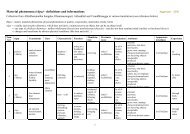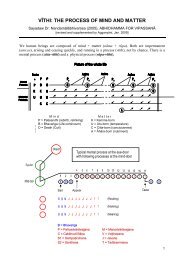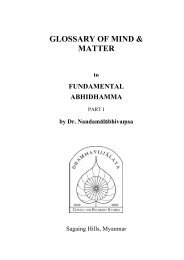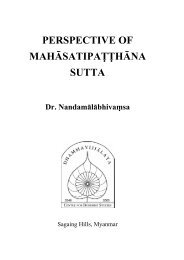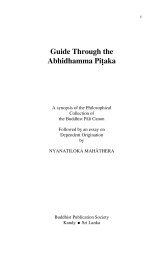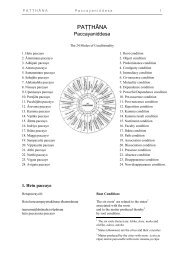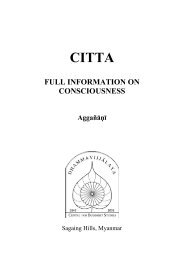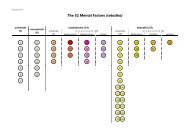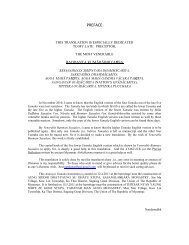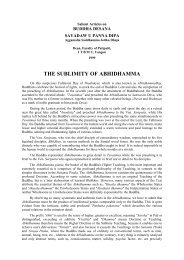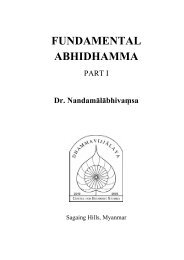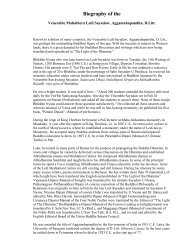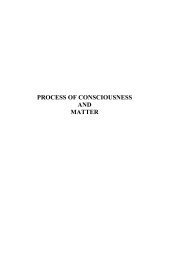ABHIDHAMMA IN DAILY LIFE - Abhidhamma.com
ABHIDHAMMA IN DAILY LIFE - Abhidhamma.com
ABHIDHAMMA IN DAILY LIFE - Abhidhamma.com
Create successful ePaper yourself
Turn your PDF publications into a flip-book with our unique Google optimized e-Paper software.
flowing freely leading to stiffness and pain. To prevent this ailment, we should avoid remaining<br />
in one posture for a long time; and take walking exercise.<br />
vi. Inhale and exhale wind - Assasapassasa<br />
Wind inhaled and exhaled by us. It is also known as anapana.<br />
10.2.5 Basic And Secondary Matter<br />
The four basic fundamental elements are earth, water, fire and wind matter while other<br />
associated matters are secondary. The four fundamental elements serve as foundation for the<br />
secondary matter. If the aggregate of the four elements are immense, we have big inorganic<br />
masses such s high mountains, big fires and immense living organisms such as big Devas, big<br />
fishes. The larger the aggregate of the four fundamental element, the bigger the size of the living<br />
or non-living thing.<br />
Other matters are secondary. They do not grow in size. Sense-objects such as sight, sound, smell,<br />
appearances are included in the class of secondary matter. For example if you add mare scent to<br />
a cake of soap, it does not reduce the scent in the cake of soap, the aroma diminishes but the size<br />
remains the same. Therefore, we must remember that only the four fundamental elements are<br />
basic matter.<br />
10.3 The Five Sense Organs<br />
Radios and televisions can receive audio as well as visual signals. In the same way in our body<br />
there are sensitive parts of the sense organs, which can receive the corresponding sense-object.<br />
10.3.1. Sensitive Part of Eye - Cakkhupadasa<br />
The sensitive part which lies at the center of the pupil and which enables one to see objects. It is<br />
made up of many cells, which can receive and <strong>com</strong>prehend various colors, lights, the senseobjects<br />
of sight. This sensitive part is the prima cause of eye-consciousness.<br />
10.3.2 . Sensitive Part of Ear - Sotapasada<br />
Inside your ear, there is sensitive part made up of many cells sensitive to sound. It can receive<br />
and interpret sounds and cause sound-consciousness.<br />
10.3.3. Sensitive Part of Nose - Ghanapasada<br />
Inside your nose, there is a special portion of many cells, which resemble the hoof of a goat. It is<br />
sensitive to scent and can produce nose-consciousness..<br />
10.3.4. Sensitive Part of Tongue - Jivhapasada<br />
In the middle of our tongue there is a collection of taste buds similar in shape to corolla of the<br />
Page 93 A Gift of Dhamma Maung Paw, California



